Roundtable Discussion: Early Treatment Options and Policies Discussed for Acute GVHD
During a Targeted Oncology case-based roundtable event, Pashna N. Munshi, MD, discussed the case of a patient who developed maculopapular rash 22 days following hematopoietic stem cell transplantion.
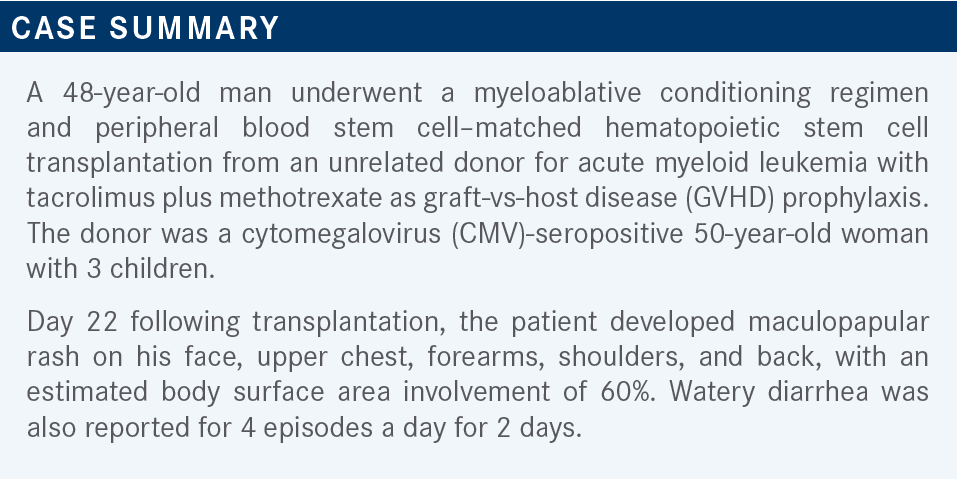

Pashna N. Munshi, MD (Moderator)
Associate Clinical Director
Stem Cell Transplant and Cellular Immunotherapy Program
MedStar Georgetown University Hospital
Washington, DC

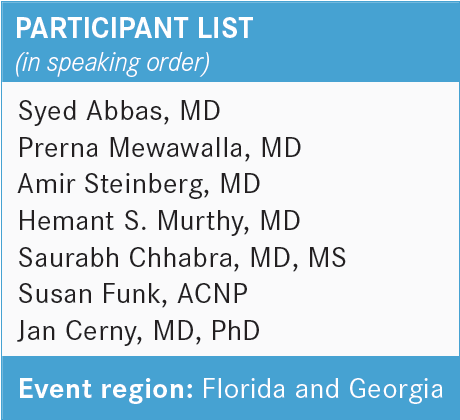
MUNSHI: Do we have room for waiting to do biopsies and waiting for these results? Or do we feel that time is of the essence, and we want to nip this inflammatory syndrome in the bud and start steroids while simultaneously testing for GVHD?
Why did you choose your answer? What are your institutional preferences and practices for grading and staging of acute GVHD?
ABBAS: In the real world, I would probably do [tests for GVHD and start steroids]. The correct answer is nipping the inflammatory syndrome in the bud [using steroids] and sending for a biopsy so you could at least know that’s what it was and not some strange viral exanthem of some kind. That’s unlikely, it’s just that in the real world, people do both.
MEWAWALLA: I agree. We do both, as well. We would do a skin biopsy right away. You don’t have to wait; it’s done an hour after we start a steroid, so we do them at the same time.
MUNSHI: What if your skin biopsy came back inconclusive or just a nonspecific inflammation? What would you do then?
MEWAWALLA: We would get the [gastroenterologists] to do an [esophagogastroduodenoscopy] and colonoscopy— mainly a colonoscopy—and they would do that the next day. But it’s finally a clinical diagnosis, so we would see [whether] the patient got better on steroids, then decide what to do next.
ABBAS: The downside of not initiating steroids in this setting is severe, so you must commit to starting steroids in this patient who’s received myeloablative conditioning, a matched unrelated donor, and is CMV seropositive. The donor was a 50-year-old woman and has this classic rash and GI [gastrointestinal] involvement, so you must start steroids, but you will get a biopsy or 2, as well, along the way.
MUNSHI: So, as Dr Abbas points out, the word classic is key here. Here is your syndrome and, as both of you pointed out, it’s a clinical diagnosis, and you’re seeing somebody with a rash—literally, in that very acute period after engraftment—22 days after transplant. If there is diarrhea at the same time, certainly think of acute GVHD, not an infection or anything else. So I would agree, our practice is to approach this as a clinical diagnosis.
For grading and staging of the involvement, MAGIC [Mount Sinai Acute GVHD International Consortium] is often used and has been used in most of the clinical trials. From 0 to 4, you have the organ staging based on the degree of skin rash.1 Our patient had 60% [body surface] involvement, so that would be stage 3. They had no liver [or upper GI] involvement but had lower GI involvement because of having 4 to 5 diarrhea episodes in a 24-hour period, which is stage 1 for lower GI. All the organ staging is put together to get an aggregate score of the clinical grade. This patient falls potentially under grade 2 acute GVHD.
This seems to be moderate GVHD. In terms of what that means for the outcomes of patients with moderate vs severe acute GVHD, there is a trial that looked at exactly that. It categorized patients into those with 1, 2, or 3 organs involved and the degree of that involvement into a standard-risk or high-risk score. They found that patients categorized as high risk were poor responders to corticosteroids, and poor responders to initial therapy had higher morbidity after an allogeneic transplant.2 These were potentially the patients who suffered the most. I don’t know [whether] we use this in our clinical practice much. I’d love to know your thoughts on it. But it guides us to saying earlier on that a patient is at high risk for worse outcomes. Therefore starting treatment sooner is more appropriate than the standard-risk patients who have either 1 organ involved or lower grades and stages of GVHD.2
The data showed the high-risk compared with standard-risk [responders] in patients treated with steroids. On day 28, the [complete response rate] for the high-risk population was much less at 27% compared with the standard-risk at 48%. The probability of transplant-related mortality at 6 months was much higher for the high-risk group at 44% compared with 22% for patients with standard-risk acute GVHD.2
STEINBERG: I’m thinking about what the data would say, not necessarily what I see in practice. I usually give steroids in such a situation, and maybe there’s [approximately] a 50% chance that it’s going to work. I was working at Mount Sinai [Cancer Center] until about 1 year ago, and we did have, as part of a consortium, a lot of scoring for the biomarkers for GVHD. If there was a trial a patient could participate in based on the biomarkers, then that’s always the No. 1 answer. I guess that’s just the board review answer. I should say it is probably a 50% chance with the steroids.
MUNSHI: Do you use biomarkers in your practice?
STEINBERG: I have not needed to in my current position, but I certainly see a role for it, especially if one is uncertain about the diagnosis, worried about how well someone’s going to respond, or [questioning] what to do next if they’re not responding well. So yes, I see a role for it.
MUNSHI: As you pointed out, you think 50% of these patients would not respond to steroids for grade 2 to 4 acute GVHD. Do we often fail to recognize steroid refractoriness or dependence in our patients? How long would you wait to call a patient steroid refractory? With the patient in this case, we’ve initiated steroids, but in your practice, if you’re suspecting it is high-risk acute GVHD and 50% refractoriness can happen, when will you pull the trigger for the next line of therapy?
ABBAS: After 7 to 14 days. If you don’t have a significant improvement and if there is large volume diarrhea, then the clinical situation will answer the question for you. But one expects to see an improvement relatively soon. If that’s not happening, then you want to consider what your next line of therapy is going to be and whether you need to check biomarkers. At my institution, severe acute GVHD and steroid refractoriness have become less common, primarily because of the bulk of posttransplant cyclophosphamide [Cytoxan; PTCy] we use.
MUNSHI: So the practices in different institutions are different and you use a lot of PTCy?
ABBAS: Yes. We use all PTCy.
MUNSHI: I am comfortable with PTCy and favor it, so I’m very familiar with that personal preference, as well.
MURTHY: Even with PTCy, if you’re doing myeloablative peripheral blood [stem cell (PBSC) transplant], you won’t have much reduction of GVHD, so we’re still getting young haploidentical patients with high-risk leukemias. We’re doing myeloablative haploidentical-PBSC, and we still get a fair number of patients [who] will have potentially severe GVHD. I guess, with my management, you need to see at least some response in 7 days, and certainly no more than 2 weeks.
The 2 aspects you’re going to use to call somebody steroid refractory or steroid dependent comes first with the initial response. Secondly, as you’re trying to taper, if you’re having difficulty pulling somebody off steroids without them having some form of flare, then you already know you’re getting into trouble. That’s how I’m looking at this. After 7 days, what’s the status of the GVHD? Is it resolved or nearly resolved? As you’re trying to quickly taper the steroids, are you having difficulty because of flares?
MUNSHI: You’ve raised 2 very important points that we, as clinicians, must think about. How soon do we want to see this go away? I think 7 days is appropriate. Both you and Dr Abbas pointed that out. Despite PTCy, you pointed out that the conditioning intensity matters. All these things can portend aggressiveness of acute GVHD matter whether you’re using peripheral graft or bone marrow graft. As Dr Steinberg pointed out, biomarkers potentially can be used. We don’t often use them, and we don’t know what to do with them sometimes, when they come back, or where to send the test, or how quickly the results come back in a lot of our practices, which are smaller centers compared with the larger centers. So, a lot to think about.
The highlights and principals of acute GVHD management with the potential goals include first-line therapy with corticosteroids. Ruxolitinib [Jakafi] is now approved as the second-line therapy for acute GVHD that’s refractory to steroids. We do want to see an improvement—ideally, we want to see a complete response if not stabilization in the manifestations. We also want to prevent any long-term toxicities, infection risk, and improve their quality of life.3
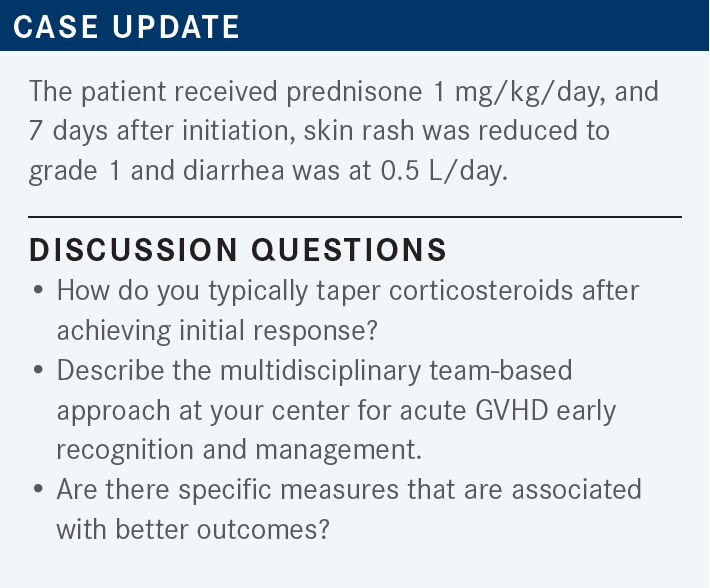
CHHABRA: We have an institutional policy to start everyone on methylprednisolone 2 mg/kg/day. Every patient should be on it for at least 3 days. Progression after 3 days, no response after 7 days, or inability to taper prednisone after 2 weeks are the scenarios, I use to determine steroid refractoriness. If I am seeing a response, then I’d like to taper prednisone 0.2 to 0.25 mg/kg every 1 to 2 weeks. I might go faster in the beginning, after seeing a response, then once the dose is lowered, I’ll go down slowly. It’s a judgement call.
MUNSHI: That’s an excellent way of approaching it. Most of us think about the 3- and 7-day window, but I love the whole “by 15 days, if we’re not able to taper” and how the dose is tapered per week, because there’s so much nuance to this. Some people just drop crudely. A patient who weighs 60 kg has a mg/kg dose of 60 mg, so they drop down straight to 50 mg, 40 mg, and keep going that way. I’m interested in this institutional policy of everyone getting 2 mg/kg vs some places, where it’s 1 mg/kg. Does anybody have thoughts on that?
FUNK: We usually start at 1 mg/kg, and if we don’t see any response in 3 days, we’ll bump it up to 2 mg/kg. Sometimes, too, we might err on the side of 1 mg/kg if it’s skin only, but if we are looking at GI and the potential toxicities are a little higher, we might start at 2 mg/kg.
ABBAS: Typically, with GI involvement, we always start with 2 mg/kg. I would agree with that.
STEINBERG: Someone once told me if you’re going to give the steroids, just go all the way to 2 mg/kg, so there’s going to be a lot of debate—even institutionally—amongst people. But I don’t know [whether] there’s a standard, per se, where I was before, but 2 mg/kg is where I lean. If you’re going to give such high doses, [you] might as well give the high dose.
MUNSHI: I absolutely agree. We want to ablate the inflammatory storm. Once it’s hitting the GI tract, we get nervous about gut GVHD and volumes of diarrhea.
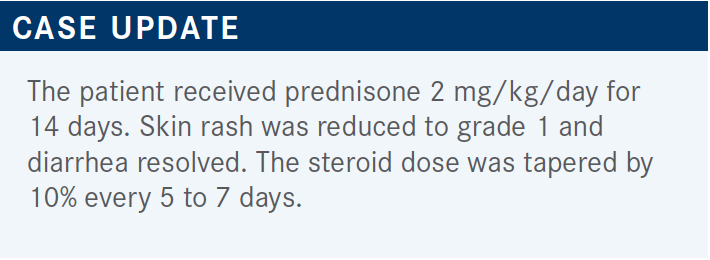
MUNSHI: Murthy, we’ve trained at the same place, where we learned FluBu [fludarabine (Fludara), busulfan (Myleran)] was the way to go, but what are your practices now?
MURTHY: Because we took some of our faculty over with me, we’re still doing a lot of FluBu. We’re not doing TAC/RAPA [tacrolimus (Prograf), rapamycin (Rapamune)], we’re doing more PTCy. Although with some regimens, we are still doing traditional TAC/MTX [tacrolimus, methotrexate (Rheumatrex)], particularly with anyone getting fludarabine/melphalan, we’re giving TAC/MTX to avoid PTCy. With that approach, we’ve been seeing less GVHD, same with the FluBu and PTCy.
In terms of a multidisciplinary team approach, dermatologists and gastroenterologists are certainly helpful when it comes to diagnosis and any time there’s a questionable diagnosis. Severe GVHD doesn’t need as much [consultation], but when you’re concerned [whether] it is a drug rash or a grade 2 skin GVHD, then dermatologists can be very helpful. If you have somebody who is presenting with anorexia and nausea and you’re wondering about an early-grade gut reaction, then gastroenterologists can be very helpful.
I also typically consult endocrinologists, because when you give high-dose steroids, you get lots of high sugars flying out of control. Steroid-induced hyperglycemia is a very big issue with high-dose steroids. So we frequently consult endocrinologists, and they’ve been very helpful in terms of telehealth, helping to manage blood sugars, and keeping patients out of the hospital.
MUNSHI: I’m not a fan of managing hyperglycemia in my clinical practice, but certainly [consulting] endocrinologists is a good thought. Does anybody think about adding [total parenteral nutrition] in drastic cases of GI GVHD if you are worried about absorption? Do you change your tacrolimus to IV [intravenous] from oral? How do you change your practice?
CERNY: We would change tacrolimus to IV because of the concern about absorption. Another specialty to consult, because this patient has CMV, and it takes only so long before the CMV may get reactivated. Dermatologists would be helpful if the patient had the kind of rash that would be suggestive of HHV-6 [human herpesvirus 6], so the biopsy would help me to not worry about HHV-6. I hope steroids would resolve the skin rash, which, unlike the gut, would worry me less as GVHD [does]. At some point, depending on [whether] the patient is not responding, we may ask gastroenterologists to rescope the patient and make sure there is nothing else and that we are still treating GVHD. Sometimes intestinal TMA [thrombotic microangiopathy] in high-grade GVHD can complicate things.
MUNSHI: It is very informative to know you worry about absorption. I dislike IV tacrolimus. I think it damages the kidneys and [when] patients are hooked up to the line, you have to use peripheral tacrolimus and it contaminates the line. So we worry about absorption, and I’ve gotten by [with it by] breaking some rules and doing daily tacrolimus levels to make sure it’s staying at the goal in the setting of acute diarrhea in patients. There’s some nuance to that, but it is very helpful to know all these different practices and how some patients may have severe intestinal involvement. Certainly, we shouldn’t be fearful of rescoping again.

CHHABRA: I feel like, [since] ruxolitinib [was] approved, most of my colleagues and I [have been] looking for an excuse to start patients on it. So for steroid-refractory GVHD, our proportion has increased.
MUNSHI: Is that because you believe ruxolitinib is better than steroids?
CHHABRA: The data are so good, and we had an expanded access program before it became approved, and we are seeing patients alive today because of it. I feel like we can start it and rapidly taper patients off the steroids and avoid all the complications of prolonged steroid use.
MURTHY: One of the worst cases I had was someone with severe steroid-refractory GI and liver GVHD. The only reason he’s alive is because of ruxolitinib, because steroids did not do anything, and we had her on photopheresis, as well, but I think it was the ruxolitinib that did it. It is the last drug I would take off for steroid-refractory GVHD. The issue with it is the cytopenia, and for that, we start at a low dose. If you’re worried about losing a graft, you may be a little concerned about that, especially very early on in a transplant. I have a very low threshold to put someone on ruxolitinib, especially if I’m not getting a quick response to steroids.
MUNSHI: [What dose do] you start your patients on? Five mg [twice daily], 10 mg [twice daily]? How high do you go?
ABBAS: The steroid-refractory setting, or for patients [who] are sluggish to respond to steroids before ruxolitinib. Everything else was equally bad, whether you gave anything from photopheresis to additional [rapamycin, or basiliximab (Simulect)]—it was all bad and patients did extremely poorly. But ruxolitinib has changed the playing field. We typically start dosing lower, but we tailor that to the degree of cytopenia patients have. As we all know, the landscape is complicated. There’s often more than one virus involved, and there’s often a bidirectional relationship between viruses like CMV, GVHD, and so on. Then we have cytopenia. So we like to go up on the ruxolitinib dose, but we always start lower. It saves a few lives in those patients [who] have been refractory to steroids.
MURTHY: I’ll also add, for most of the patients [who] got to this point, before ruxolitinib, the best option was sirolimus [Rapamune]. The issue you had is most of the patients were still on full-dose therapeutic tacrolimus, so having to adjust tacrolimus with the addition of sirolimus would risk a TMA. It was extremely complicated, so ruxolitinib made it a whole lot easier not having to go to sirolimus.
MUNSHI: Yes, that’s a great point, especially if you’re using conditioning regimens, like busulfan, that affect the liver, increasing the risk of sinusoidal obstruction syndrome with additional sirolimus to a calcineurin inhibitor.
REFERENCES
1. Harris AC, Young R, Devine S, et al. International, multicenter standardization of acute graft-versus-host disease clinical data collection: a report from the Mount Sinai Acute GVHD International Consortium. Biol Blood Marrow Transplant. 2016;22(1):4-10. doi:10.1016/j.bbmt.2015.09.001
2. MacMillan ML, Robin M, Harris AC, et al. A refined risk score for acute graft-versus-host disease that predicts response to initial therapy, survival, and transplant-related mortality. Biol Blood Marrow Transplant. 2015;21(4):761-767. doi:10.1016/j.bbmt.2015.01.001
3. Im A, Hakim FT, Pavletic SZ. Novel targets in the treatment of chronic graft-versus-host disease. Leukemia. 2017;31(3):543-554. doi:10.1038/leu.2016.367
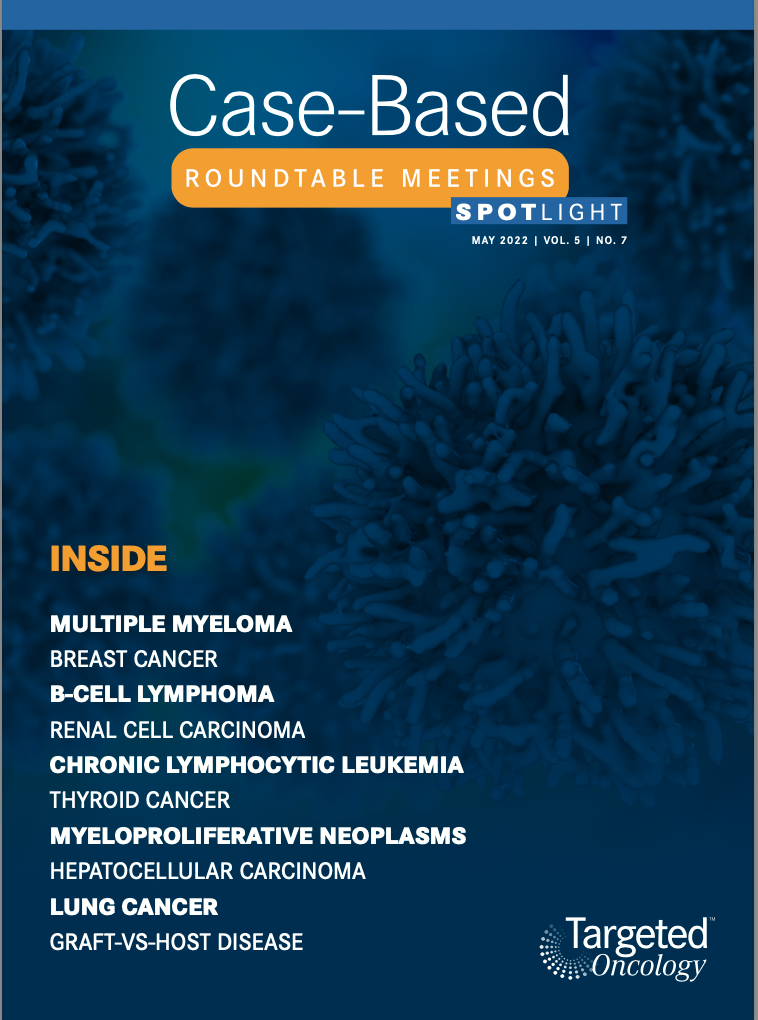
Survivorship Care Promotes Evidence-Based Approaches for Quality of Life and Beyond
March 21st 2025Frank J. Penedo, PhD, explains the challenges of survivorship care for patients with cancer and how he implements programs to support patients’ emotional, physical, and practical needs.
Read More